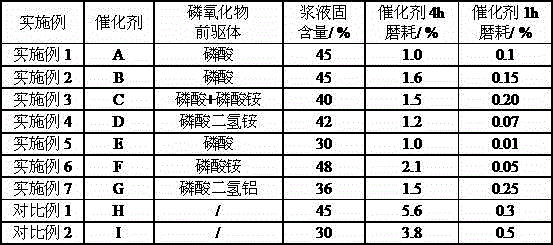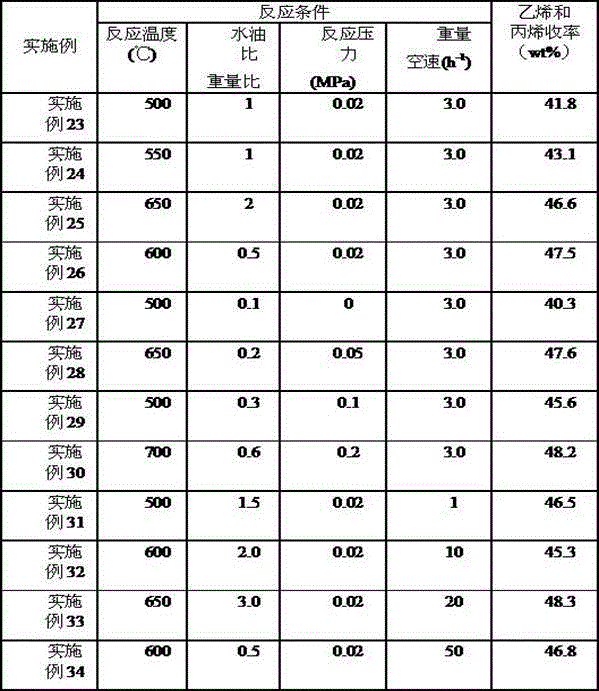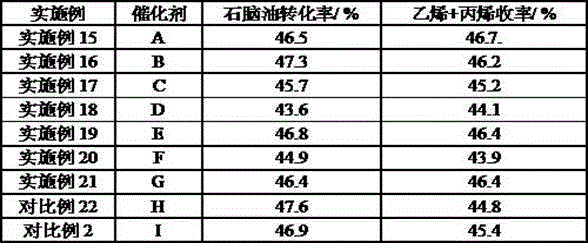Highly wear-resistant naphtha catalytic cracking to olefin fluidized bed catalyst
A fluidized bed catalyst and catalytic cracking technology, which is applied in the direction of physical/chemical process catalysts, hydrocarbon cracking hydrocarbon production, molecular sieve catalysts, etc., can solve the problem of large wear of naphtha catalytic cracking fluidized bed catalysts, and achieve anti-wear performance The effect of improving, increasing solid content, and improving production efficiency
- Summary
- Abstract
- Description
- Claims
- Application Information
AI Technical Summary
Problems solved by technology
Method used
Image
Examples
Embodiment 1
[0039] 1) Weigh 160g of water and 12g of concentrated phosphoric acid, mix them evenly, add 180g of aluminum sol, 120g of kaolin and 100g of ZSM-5 molecular sieve, and use a colloid mill to intensively mix for 20min to obtain the slurry required for spray drying.
[0040] 2) The obtained slurry was spray-dried into microspheres of 20-200 μm, which were calcined at 600°C for 4 hours to form.
[0041] 3) Take 150g of the formed microspheres, use lanthanum nitrate solution as impregnation solution, load rare earth element lanthanum by impregnation method, and finally dry at 120°C for 10h and burn at 600°C for 4h to obtain fluidized bed catalyst A for catalytic cracking of naphtha to olefins , the content of lanthanum metal in the obtained catalyst is 1.0%. The results of the attrition measurements of the catalysts are listed in Table 1. The particle size of the catalyst particle distribution is 70um; the specific surface area of the catalyst is 200m 2 / g; catalyst pore volume...
Embodiment 2
[0044] The difference from Example 1 is that in the slurry preparation process, the amount of concentrated phosphoric acid added was 3.0 g, and the remaining steps were the same as in Example 1 to obtain catalyst B, and the particle size distribution of the catalyst particles was 75um; the catalyst specific surface area was 300m. 2 / g; catalyst pore volume is 0.26 m 3 / g; the Si / Al atomic ratio of ZSM-5 molecular sieve is 30. The results of the attrition measurements of the catalysts are listed in Table 1.
Embodiment 3
[0046] 1) Weigh 210g of water, 5g of ammonium phosphate, and 2g of phosphoric acid to dissolve evenly, add 160g of aluminum sol, 100g of kaolin, and 110g of ZSM-5 molecular sieve, and use a colloid mill to vigorously mix for 30min to obtain the slurry required for spray drying.
[0047] 2) The obtained slurry was spray-dried into microspheres of 20-200 μm, which were calcined at 650°C for 2 hours to form.
[0048] 3) Take 150g of formed microspheres and load 1.5% rare earth element cerium by impregnation method. Drying at 100°C for 16h, and calcining at 580°C for 8h to obtain a fluidized bed catalyst C for catalytic cracking of naphtha to olefins, the catalyst particle size distribution is 65um; the catalyst specific surface area is 250m 2 / g; catalyst pore volume is 0.3 m 3 / g; the Si / Al atomic ratio of ZSM-5 molecular sieve is 50. The results of the attrition measurements of the catalysts are listed in Table 1.
[0049]
PUM
| Property | Measurement | Unit |
|---|---|---|
| Pore volume | aaaaa | aaaaa |
| Pore volume | aaaaa | aaaaa |
| Particle size | aaaaa | aaaaa |
Abstract
Description
Claims
Application Information
 Login to View More
Login to View More - Generate Ideas
- Intellectual Property
- Life Sciences
- Materials
- Tech Scout
- Unparalleled Data Quality
- Higher Quality Content
- 60% Fewer Hallucinations
Browse by: Latest US Patents, China's latest patents, Technical Efficacy Thesaurus, Application Domain, Technology Topic, Popular Technical Reports.
© 2025 PatSnap. All rights reserved.Legal|Privacy policy|Modern Slavery Act Transparency Statement|Sitemap|About US| Contact US: help@patsnap.com



